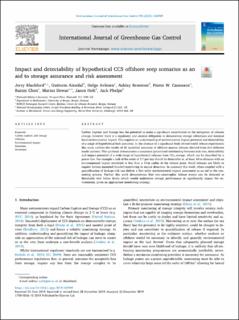| dc.contributor.author | Blackford, Jerry | |
| dc.contributor.author | Alendal, Guttorm | |
| dc.contributor.author | Avlesen, Helge | |
| dc.contributor.author | Brereton, Ashley | |
| dc.contributor.author | Cazenave, Pierre W | |
| dc.contributor.author | Chen, Baixin | |
| dc.contributor.author | Dewar, Marius | |
| dc.contributor.author | Holt, Jason | |
| dc.contributor.author | Phelps, Jack | |
| dc.date.accessioned | 2020-04-27T12:54:45Z | |
| dc.date.available | 2020-04-27T12:54:45Z | |
| dc.date.created | 2020-03-01T15:55:44Z | |
| dc.date.issued | 2020 | |
| dc.identifier.issn | 1750-5836 | |
| dc.identifier.uri | https://hdl.handle.net/11250/2652658 | |
| dc.description.abstract | Carbon Capture and Storage has the potential to make a significant contribution to the mitigation of climate change, however there is a regulatory and societal obligation to demonstrate storage robustness and minimal local environmental impact. This requires an understanding of environmental impact potential and detectability of a range of hypothetical leak scenarios. In the absence of a significant body of real-world release experiments this study collates the results of 86 modelled scenarios of offshore marine releases derived from five different model systems. This synthesis demonstrates a consistent generalised relationship between leak rate, detectability and impact potential of a wide range of hypothetical releases from CO2 storage, which can be described by a power law. For example a leak of the order of 1 T per day should be detectable at, at least, 60 m distance with an environmental impact restricted to less than a 15 m radius of the release point. Small releases are likely to require bottom mounted (lander) monitoring to ensure detection. In summary this work, when coupled with a quantification of leakage risk can deliver a first order environmental impact assessment as an aid to the consenting process. Further this work demonstrates that non-catastrophic release events can be detected at thresholds well below levels which would undermine storage performance or significantly impact the environment, given an appropriate monitoring strategy. | |
| dc.language.iso | eng | |
| dc.relation.uri | sciencedirect.com/science/article/pii/S1750583619304116 | |
| dc.rights | CC BY 4.0 | |
| dc.rights.uri | https://creativecommons.org/licenses/by/4.0/ | |
| dc.title | Impact and detectability of hypothetical CCS offshore seep scenarios as an aid to storage assurance and risk assessment | |
| dc.type | Peer reviewed | |
| dc.type | Journal article | |
| dc.rights.holder | © 2020, The Authors. | |
| dc.description.version | publishedVersion | |
| cristin.ispublished | true | |
| cristin.fulltext | original | |
| cristin.qualitycode | 2 | |
| dc.identifier.doi | 10.1016/j.ijggc.2019.102949 | |
| dc.identifier.cristin | 1798752 | |
| dc.source.journal | International Journal of Greenhouse Gas Control | |
| dc.source.volume | 95 | |
| dc.relation.project | EC/H2020/654462 | |
| dc.relation.project | Norges forskningsråd: 254711 | |
| dc.relation.project | Norges forskningsråd: 305202 | |
| dc.relation.project | EC/H2020/294766 | |

